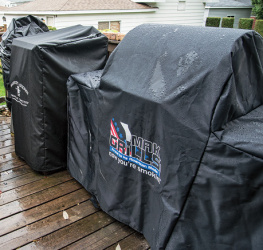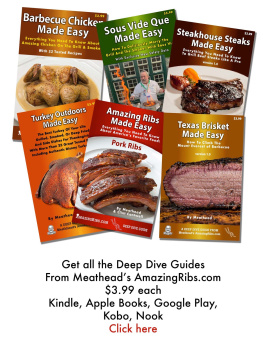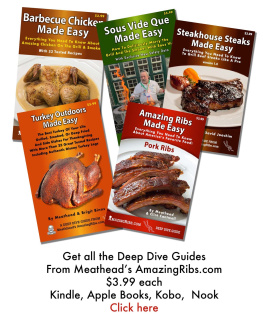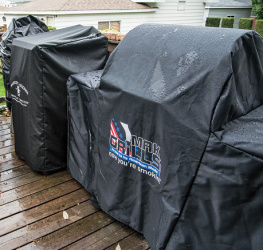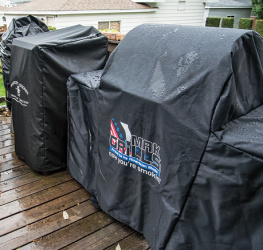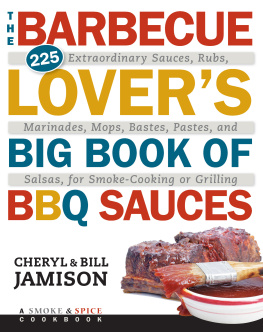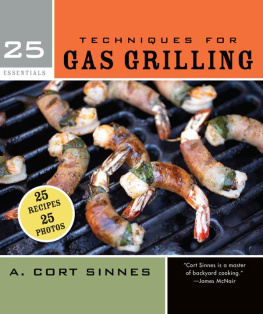Text, photographs, and illustrations copyright 2016 by AmazingRibs.com
All rights reserved
For information about permission to reproduce selections from this book, write to trade.permissions@hmhco.com or to Permissions, Houghton Mifflin Harcourt Publishing Company, 3 Park Avenue, 19th Floor, New York, New York 10016.
www.hmhco.com
Library of Congress Cataloging-in-Publication Data
Names: Goldwyn, Meathead, author.
Title: Meathead : the science of great barbecue and grilling / text and photos by Meathead Goldwyn ; with Greg Blonder, Ph.D.
Other titles: Science of great barbecue and grilling
Description: Boston : A Rux Martin Book, Houghton Mifflin Harcourt, 2016.
Identifiers: LCCN 2015049143 (print) | LCCN 2015050718 (ebook) | ISBN 9780544018464 (hardback) | ISBN 9780544018501 (ebook)
Subjects: LCSH: Barbecuing. | BISAC: COOKING / Methods / Barbecue & Grilling. | COOKING / General. | LCGFT: Cookbooks.
Classification: LCC TX840.B3 G63 2016 (print) | LCC TX840.B3 (ebook) | DDC 641.7/6dc23
LC record available at http://lccn.loc.gov/2015049143
Book design by Endpaper Studio
Ebook design and production by Rebecca Springer
Illustrations by Lisa Kolek
Cover photo by John Boehm, jboehmphoto.com
v1.0516
Additional photographs provided by Adrenaline Barbecue Company,
To Lou, my wife of forty-one years, a Ph.D. microbiologist and food safety expert, who loves food and cooking as much as I do. She fearlessly eats my experiments (well, most of them), offers honest feedback (brutally honest), and has the patience of a pitmaster (most of the time). She is still the better cook.
Contents
Foreword
This is the book barbecue nerds have been waiting for. Myth and lore abounds in the world of cooking, and nowhere more so than in the primal arena that exists when humans put open fire and meat together in the great outdoors (or suburban backyard, as the case may be). Thats good news for anyone who, like me, longs to understand the science of grilling and barbecue; the thermodynamics of heat transfer under that kettle dome, the chemistry of the smoke ring, and what makes a char-grilled steak so g*&@%# delicious.
Meatheads gift lies not just in factual accuracy, but also in being able to distill complex subjects to their most essential, applicable core in a manner that is a genuine pleasure to read. Youll laugh out loud at his metaphors. A good technical writer will leave you feeling like you know more than when you started. A great one can leave you feeling like more than a passive bystander. Itll make you feel like an active participant, like youve been on a voyage of discovery for yourself. Flipping over each page to discover what lies on the next will remind you of the very first time you peeked under the cover of your grill and breathed in the alchemy that occurs between smoke and meat. Youll see conventions challenged, techniques elucidated, and myths busted, and youll have a wildly fun time in the process.
With hundreds of pages on techniques, theory, equipment, and background science before you even get to the recipes, this is a book that is squarely aimed at cooks who dont just want a single good rack of ribs coming off their grill, but who want to understand what makes them good and how to repeat it time after time. Soak in enough of the background technique and you wont even need a recipe. You have all the tools you need to develop your own. I love to grill but Im no barbecue guru. After reading Meathead , Im gonna be pretty darned good at faking it though.
J. Kenji Lpez-Alt,
Author of The Food Lab
Welcome
Recipe writers hate to write about heat. They despise it. Because there arent proper words for communicating what should be done with it.
Alton Brown
T his is the way I think we got here: Millions of years ago a hunting party of hominids stumbled upon the charred carcass of an animal after a forest fire. The smell and taste were ethereal, and the next beast they speared went right into their campfire. And thus began the struggle to master fire, heat, smoke, and meat.
The cooked meat must have seemed miraculous to them because they knew nothing about the components of smoke; the differences between convection, conduction, and radiation; the power of infrared energy; the Maillard reaction; the conversion of collagen to gelatin; the caramelization of sugar; and the isoelectric properties of salt.
And, sadly, neither do most modern backyard cooks, who throw meals into the sacrificial pyre and are doomed to serve carbon-coated chicken wings and hockey-puck hamburgers. Many of us are cavemen in a digital age.
But barbecue and grilling are not magic. Every recipe we cook is a physics and chemistry experiment. Outdoor cooking, though, is a lot harder than indoor cooking. Very few outdoor ovens have a thermostat to control temperature (and a grill is really a crude oven), and just when you think you know how to make the perfect steak, cold air, wind, and rain embarrass you by cooling your fire and food and screwing everything up. And then theres smoke, the ephemeral spice that can go from aphrodisiac to ashtray if you dont know what you are doing.
We all have painful memories of epic failures, but they are avoidable. Understanding is the first step in mastery. This book explains the science of barbecuing and grilling in lay terms. Along the way, I use science to filter the hogwash, bust the myths, and take down the old husbands tales and canards passed along by pitmasters whose rituals have gone largely untested since that first forest fire.
For help, I consulted several scientists, chief among them Professor Greg Blonder, Ph.D., of Boston University. A physicist, he conducted original experimental research for this book and the barbecue website I founded, AmazingRibs.com. With his input and that of others, Ill share techniques guaranteed to improve your cooking.
Three core concepts alone can elevate your food from the ordinary: two-zone set-up, reverse sear, and the use of digital thermometers. Master them and someday your children will tell their children, Heres how Dad taught me to grill a steak. And thus you will achieve immortality.
Technique. My motto is Give a man a fish, and hell probably get it stuck to his grill. Teach a man to grill, and hell become a big fish among his family and friends. With this book, you will learn how to keep fish fillets from sticking to the grill; how to make your own rubs that taste much better and cost far less than store-bought; and how to amp up tomato sauce by grilling the tomatoes. Youll also learn that cooking time depends on the thickness of the food, not its weight; why you shouldnt soak wood for smoking; why sticking a beer can up a chickens butt is a waste of good beer; why rubs should not have salt in them; and that you shouldnt bring cold meat to room temperature before cooking because cold meat attracts smoke better. Do you know why you should avoid making grill marks on your steaks? And that resting meat after cooking can do more harm than good?
If you are skeptical, thats all the more reason to read this book.
Hardware. Whether you are shopping for your first grill or your yard has enough steel to build a battleship, I think youll find the equipment recommendations useful and at times surprising. They were compiled with the help of my associate Max Good, whose full-time job is kicking the tires of grills and smokers.

